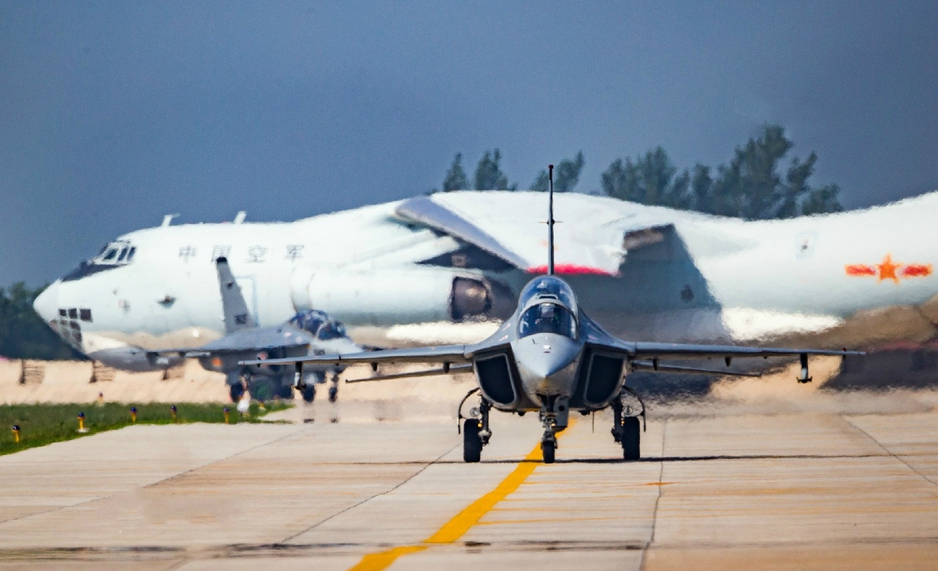You should take into account the time spent in port when you consider how much usable carrier capacity the Chinese will have. But for a show of force, even a single carrier might be enough. Remember what the Russians did with the Kuznetsov. They sailed it all around Europe to the other side of the Mediterranean to support ops in Syria. Despite its bad condition. I would not be surprised to see China do the same, say in an operation in the Middle East, if they felt the need to do it. I have no reason to think the Chinese couldn't put two carrier groups on the sea at the same time operationally on a mission, if they wanted to, in a couple years time for a show of force.
Since they have multiple crews on the Liaoning, which was used as a training carrier, and they also have land based training facilities the time to put two carriers into service simultaneously would not be that long. Also unlike Russia, the Chinese have the oiler and suply ships to make long distance missions already available. Even without the Type 055, which will be available by then, the amount of destroyers and frigates they have already would be quite enough to serve as carrier escorts for two carriers.
As for stealth aircraft it remains to be seen what's their operational reliability and how the stealth coatings handle sea conditions. The USA is just now putting the F-35C to test on its own carriers. I think China has no reason to rush their naval stealth fighter until the CATOBAR carrier class comes out. The STOBAR carriers can be used in a show of force against low-level nations. But against peer or near peer nations even if you used them you would need better aircraft and cruiser coverage. Which I expect will happen eventually. I think a lot of people fail to realize that the Chinese clones of the Su-27 use a lot of composite materials in their construction already. More than the original Su-27 does. So I expect it to be kind of similar to the Eurofighter in terms of low observability characteristics. What it cannot do (yet) is supercruise. If there is something which is a danger IMHO is the present lack of Chinese naval AWACS aircraft in service at the moment. With regards to the J-15 it needs to be enhanced with better engines to maximize the thrust-to-weight ratio and increase the combat payload. To compete with the Super Hornet it also needs some equivalent of the JHMCS. With that and improved avionics it should pose a significant threat to the bulk of the opposition aircraft it might be used against.
Since they have multiple crews on the Liaoning, which was used as a training carrier, and they also have land based training facilities the time to put two carriers into service simultaneously would not be that long. Also unlike Russia, the Chinese have the oiler and suply ships to make long distance missions already available. Even without the Type 055, which will be available by then, the amount of destroyers and frigates they have already would be quite enough to serve as carrier escorts for two carriers.
As for stealth aircraft it remains to be seen what's their operational reliability and how the stealth coatings handle sea conditions. The USA is just now putting the F-35C to test on its own carriers. I think China has no reason to rush their naval stealth fighter until the CATOBAR carrier class comes out. The STOBAR carriers can be used in a show of force against low-level nations. But against peer or near peer nations even if you used them you would need better aircraft and cruiser coverage. Which I expect will happen eventually. I think a lot of people fail to realize that the Chinese clones of the Su-27 use a lot of composite materials in their construction already. More than the original Su-27 does. So I expect it to be kind of similar to the Eurofighter in terms of low observability characteristics. What it cannot do (yet) is supercruise. If there is something which is a danger IMHO is the present lack of Chinese naval AWACS aircraft in service at the moment. With regards to the J-15 it needs to be enhanced with better engines to maximize the thrust-to-weight ratio and increase the combat payload. To compete with the Super Hornet it also needs some equivalent of the JHMCS. With that and improved avionics it should pose a significant threat to the bulk of the opposition aircraft it might be used against.


